
|
|
Note: Check Photo Glossary or a good dictionary for any terms unfamiliar to you. See Maps and accompanying caption for place names.
Maps updated on August 24
| Current Deformation |
| Images and Chronology |
8 October 2004
Pu`u `O`o and PKK
 |
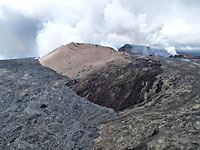 |
| Left. Fume, thick enough to require a gas mask, issues from cracks between June 25 spatter cone and south base of Pu`u `O`o, visible at upper right edge of image. Sulfur lines many cracks. 0814. Right. Aerial view looking northwestward at Pu`u `O`o. Lava flows surround lighter cone, made of scoria and spatter. Part of crater visible in upper right; largest fume column comes from East Pond Vent. June 25 cone, shown in left image, is barely visible at distant base of Pu`u `O`o. 1242. | |
 |
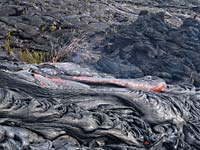 |
| Left. Small breakout along edge of PKK flow at 1650-foot elevation on Pulama pali. Ferns grow on flow surface about 2 yr old. 0959. Right. Another breakout within confines of PKK flow at same elevation. 1001. | |
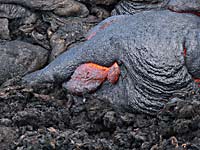 |
 |
| Left. Sluggish lava emerges from elephant-skinned toe of pahoehoe, 1540-foot elevation, Pulama pali. Such sluggish lava is common in this area and reflects somewhat cooler temperature than for the breakouts shown above. Right. Several small breakouts near east edge of PKK flow at 1540-foot elevation. Note mound of small tongues built over past several days. 1016. | |
27 September 2004
Harvest Moon through vog
 |
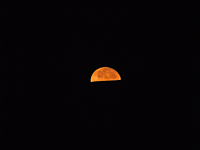 |
| Full Harvest Moon typically appears brown-yellow through smoke from burning fields after harvest. At Kilauea, that color often indicates vog. In these views, nearly full moon takes on dirty amber cast as viewed through plume of vog coming from Pu`u `O`o. Photo location is Kealakomo overlook. Left. Just starting to set behind Mauna Loa's southwest rift zone. 0515:30. Right. Going, going... 0516:14. | |
24 September 2004
Down the PKK flow from Puka Nui
 |
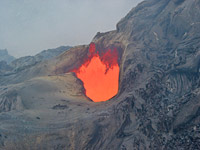 |
| Left. June 25 spatter cone near Puka Nui on south side of Pu`u `O`o. This cone grew substantially in past week and is emitting sloshing sounds from lava just below it. Flank of Pu`u `O`o in background, through fume. Figure preparing to take image shown to right. 0955. Right. Close view of hole in June 25 spatter cone. 0959. | |
 |
 |
| Left. Looking up PKK lava tube toward Pu`u `O`o (upper left). Newly formed skylight in lower left. Fume and altered rock (white) define course of tube. 1431. Right. Small breakout in western arm of PKK flow downstream from area shown in left image. Pu`u `O`o in background. 0914. | |
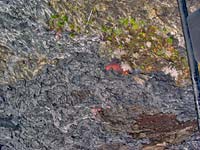 |
 |
| Left. Aerial view of several breakouts near terminus of western arm of PKK flow. Note the two distinctly different shades of gray. Darker hue is older crust, but lava is still flowing under it. 1258. Right. Aerial view looking up the western arm of PKK flow (center of image, lighter toned than surroundings. Terminus is along small kipuka in lower center. Pu`u `O`o in background. 0856. | |
| Current Deformation |
Map of selected deformation stations
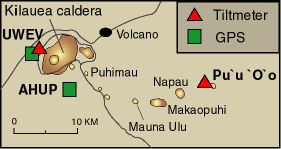
Electronic Tiltmeter
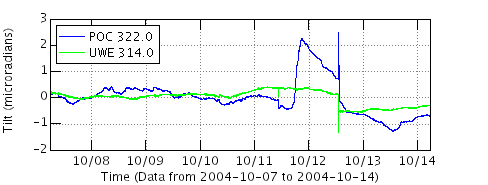 The Uwekahuna tilt flattened early on October 6 and remained flat until October 7. Pu`u `O`o showed net deflation through the 6th and into the 7th, with a midday deflation-inflation superposed on the overall trend. Both stations deflated for most of October 7, Pu`u `O`o eventually losing about 0.8 microradians since late October 6 and 1.3 microradians since early October 5. The deflation turned into inflation in the afternoon of October 7 at Pu`u `O`o and in the evening at Uwekahuna. The inflation continued into the morning of October 8. Then the tilt at Pu`u `O`o leveled off, and both stations showed flat tilt into October 9. The tilt remained flat at Uwekahuna through the 9th and into October 10, but it deflated irregularly at Pu`u `O`o during the same time. Pu`u `O`o continued to deflate until just before noon and then started to inflate. The inflation lasted until early October 11, when it turned over into slow deflation. Uwekahuna was flat to gently deflating for the first half of October 10, but it then began an inflation that lasted into the 11th. The tilt at Uwekahuna leveled off early on October 11, and that at Pu`u `O`o started to deflate. A M4.0 earthquake at 1020 caused a spike at Uwekahuna and a permanent offset of about 0.3 microradians at Pu`u` O`o. Later in the day, heavy rain at Pu`u `O`o, about 18 cm in 5 hours, induced a spurious tilt that clouded the Pu`u `O`o record for the rest of the day and into October 12. Uwekahuna maintained its flat tilt into October 12. Another earthquake, of M4.5, offset both tiltmeters at 1318 on the 12th. Tilt trends continued after the earthquake. Uwekahuna slowly inflated through October 13 into October 14. Pu`u `O`o, on the other hand, continued its recovery from the October 11 rainfall, eventually bottoming out at midday on October 13 and starting a slow inflation that lasted into the 14th. |
|
This graph shows the radial tilt at Uwekahuna (UWE), on the northwest rim of Kilauea's caldera, and at Pu`u `O`o cone (POC), on the northwest flank of the active vent along the east rift zone, as recorded by continuously operating electronic tiltmeters. Positive changes indicate inflation of the magma storage areas beneath the caldera or Pu`u `O`o. Data are shown for a one-week period. A long-term trend of constant-rate, large deflation at Pu`u `O`o used to be removed for scale reasons, but starting on May 24, 2002, the tilt is shown as recorded, including the long-term deflation. The graph is refreshed at the same time as the eruption update at the top of this page, usually daily. The Y-axis is in microradians, an angular measure in parts per million; for example, one microradian represents the tilt of a 1-km-long bar, one end of which is lifted up or down 1 mm. |
Global Positioning System (GPS)
 Two years of data are shown in the plot.
Slow inflation ended in late May 2002, and by late June deflation
began, causing the distance to shorten gradually. The distance may
have lengthened a little in September and early October 2002 before
resuming its slow contraction. Slow lengthening resumed in
mid-November and continued for a month or so. A brief period of
contraction followed, but by early January 2003 the distance had
become stable. Thereafter it started to lengthen as the summit began
to swell. The lengthening has been at a gradually increasing rate,
broken only by a brief period of slowing in March 2004. Starting in
late April or May, the rate of extension noticeably picked up but
then slowed to its normal rate. At the end of July, the extension
ended rather abruptly, and currently very slow contraction is taking
place. Two years of data are shown in the plot.
Slow inflation ended in late May 2002, and by late June deflation
began, causing the distance to shorten gradually. The distance may
have lengthened a little in September and early October 2002 before
resuming its slow contraction. Slow lengthening resumed in
mid-November and continued for a month or so. A brief period of
contraction followed, but by early January 2003 the distance had
become stable. Thereafter it started to lengthen as the summit began
to swell. The lengthening has been at a gradually increasing rate,
broken only by a brief period of slowing in March 2004. Starting in
late April or May, the rate of extension noticeably picked up but
then slowed to its normal rate. At the end of July, the extension
ended rather abruptly, and currently very slow contraction is taking
place. |
|
This graph shows the change in distance between two Global Positioning System (GPS) stations located on opposite sides of Kilauea's caldera. A rapid increase in distance can be interpreted as inflation of the summit magma reservoir. The graph is refreshed at the same time as the eruption update at the top of this page, usually daily. |
| For more information on how electronic tiltmeters and GPS receivers help monitor the deformation of Kilauea and Mauna Loa volcanoes, see a summary of the inflation-deflation of magma chambers. |
| Maps of lava-flow field, Kilauea Volcano |
Map of flows from Pu`u `O`o: 24 August 2004
Map shows lava flows erupted during 1983-present activity of Pu`u `O`o and Kupaianaha (see large map).
Shades of red and bright yellow denote Mother's Day flow field, which began erupting on May 12, 2002 and continues to the present. Darkest red indicates lava flows erupted in November 2003-24 August 2004, including the labeled Banana flow, which developed gradually starting in the middle of April. Orange shade denotes MLK flow, erupted in January and, in brief spurts, subsequently. Yellow shade indicates Kuhio (PKK) flow, active most of the time from March 20 to August 24. As of August 24, most activity was located in the Banana flow, fed by the Banana branch of the Mother's Day tube. The PKK flow remains active, too.
Through September and into early October 2003, lava was moving along the east and west sides of the Mother's Day flow. The east-side lava (known as the August 9 breakout) came from the August 9 rootless shield, itself fed by the main Mother's Day tube from Pu`u `O`o. The west side lava, known as the Kohola arm of the Mother's Day flow, branched off the tube system below the rootless shield.
In early October 2003, the August 9 breakout stopped moving, the Kohola died back to a trickle, and the one labeled rootless shield gained prominence. By October 16, however, the shield had partly collapsed, leaving several drained perched ponds behind. Upstream from the shield, many hornitos and small flows formed over the Mother's Day tube. Soon thereafter, other rootless shields began to form over the Mother's Day, August 9, and Kohola tubes.
New vents opened at the southern base of Pu`u `O`o on January 19 and fed Martin Luther King (MLK) flows, which remained active until March 5. Several small vents formed during this time. On March 20, Kuhio (PKK) flow originated from two vents, main one about 250 m south of base of Pu`u `O`o. This flow has remained active most of the time to the August 24 date of this map.
The Banana flow developed from breakouts from the Mother's Day lava tube, centered near the former Banana Tree kipuka. The breakouts become prominent in the middle of April, and lava started down Pulama pali shortly thereafter. This is the time that we assigned the name Banana to the flow.
Vents in West Gap Pit became active in early October, were quiet for 3 weeks, and then resumed intermittent activity that continued well into December. Other vents were also sporadically active in Puka Nui (near West Gap Pit) and in the crater of Pu`u `O`o.
Map of Pu`u `O`o and vicinity: 24 August 2004
Map shows vents, lava flows, and other features near Pu`u `O`o frequently referred to in updates (see large map). These features change often, but this map should help those viewers lost in the terminology. The cones in West Gap are just outside the boundary of the crater--the oval-shaped depression containing the seven numbered vents (now down to 6, as Humble Vent has been buried by a mound of lava flows erupted from Dave's Pit/Vent in March. Red color denotes flows--the Mother's Day flows--erupted since May 12, 2002. Light orange color indicates episode-55 flows erupted between March 1997 and August 2002 (exclusive of Mother's Day flows). Darker orange represents MLK flows; yellow, PKK flow; purple, Puka Nui flow. Vents for these sets of flows shown by indicated symbols. Gray shows flows of earlier episodes.
Eruption-viewing opportunities change constantly, so refer to this page often. Those readers planning a visit to Kilauea or Mauna Loa volcanoes can get much useful information from Hawai`i Volcanoes National Park.
The URL of this page is http://hvo.wr.usgs.gov/kilauea/update/
Contact: hvowebmaster@usgs.gov
Updated: 14 October 2004 (DAS)

